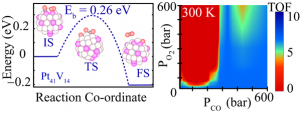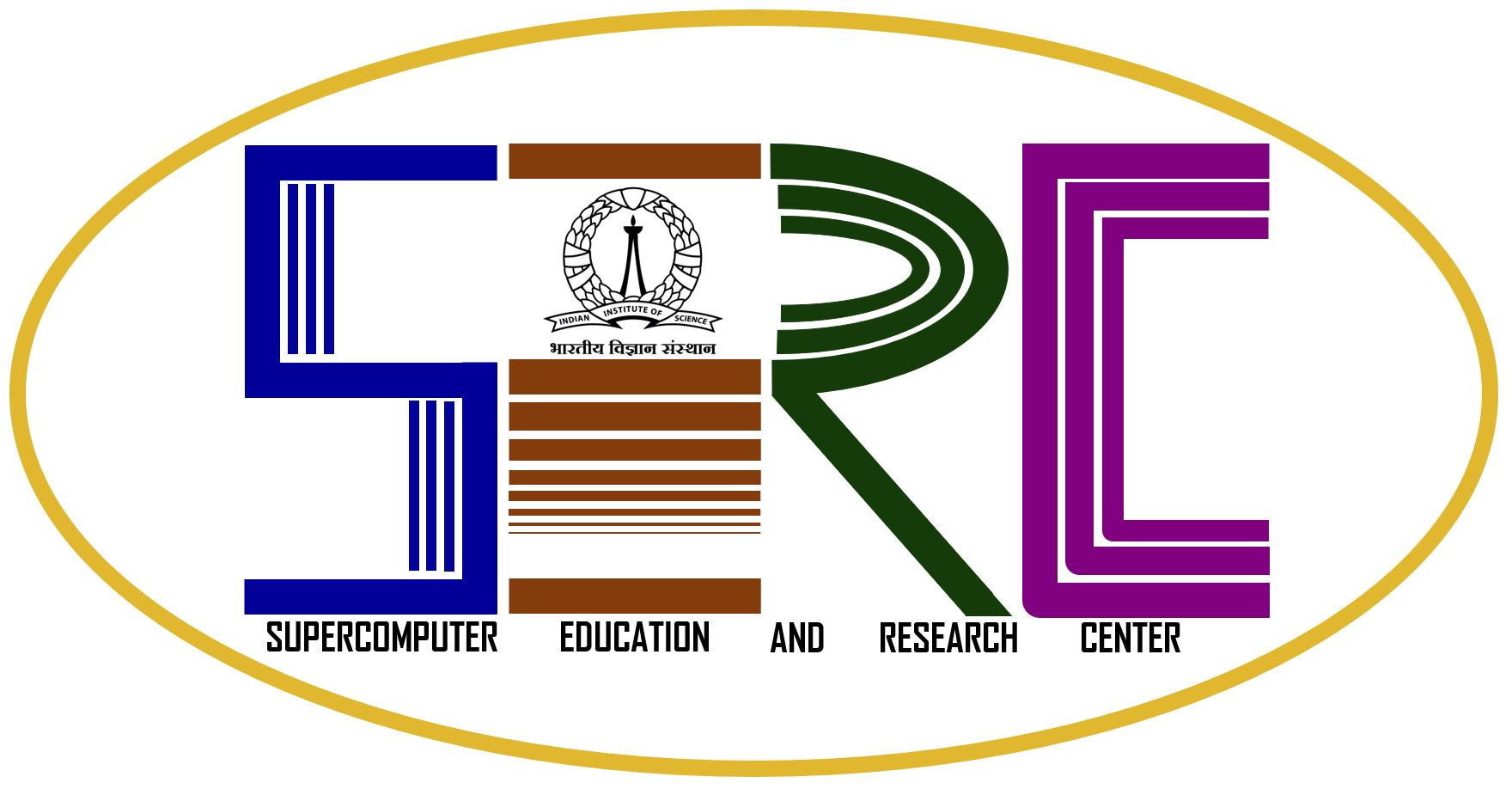
Reaction barrier and turn over frequency on 55 atom cluster supported on MgO (100)
Prof. Abhishek Singh’s lab in Material Research Centre has used SERC HPC facility in 2017, involving 14.4 million core hours, for computational modelling of materials, especially in applications, where extensive computational resources were required. The main problems solved using this facility include the reaction barrier calculations, discovering novel topological materials and determining their exotic topological properties, calculating GW band gaps, evaluation of the anharmonic contributions to the lattice thermal conductivity of thermoelectric materials, and the determination of polarization of ferroelectric materials.
“Typical execution times using SERC HPC systems were 24 hours or 72 hours. The same task would have taken at least an order of magnitude more time on the local facility”, says Prof. Abhishek.
Publications
1. Simultaneous site adsorption shift and efficient CO oxidation induced by V and Co in Pt Catalyst, R. Ahmad and A. K. Singh, J. Phys. Chem., 121, 12807 (2017)
2. Topologically nontrivial electronic states in CaSn3, S. Gupta, R. Juneja, R. Shinde, and Abhishek K. Singh, J. Appl. Phys. 121, 214901 (2017)
3. High Thermoelectric Performance in n-doped Silicon-Based Chalcogenide Si2Te3, R. Juneja, T. Pandey and A. K. Singh, Chem Mater. 29, 3723 (2017)
4. Ferroelectricity, Antiferroelectricity and Ultrathin 2D Electron/Hole Gas in Multifunctional Monolayer MXene, A. Chandrasekaran, A. Mishra, and A. K. Singh, Nano Lett., 17, 3290 (2017)
5. Strain-induced indirect to direct band gap transition in bulk SnS2, B. Ram and A. K. Singh, Phys. Rev. B, 95, 075134 (2017)
6. Atomistic Origin of Phase Stability in Oxygen Functionalized MXene: A Comparative Study, A. Mishra, P. Srivastava, A. Carreras, I. Tanaka, H. Mizuseki, K.-R. Lee, and A. K. Singh, J. Phys. Chem. C, 121, 18947 (2017)
7. Monolayer BC2: an ultrahigh capacity anode material for Li ion batteries, D. Das, R. Hardikar, S.-S. Han, K.-R. Lee, and A. K. Singh, Phys. Chem. Chem. Phys., 19, 24230 (2017)
8. Existence of Tii2+ states on the surface of heavily reduced SrTiO3 nanocubes, S. Shetty, S. K. Sinha, R. Ahmad, A. K. Singh, G. Van Tendeloo, and N. Ravishankar, Chem. Mater., 29, 9887 (2017)
9. Graphene Oxide Epoxy (GO-xy): GO as Epoxy Adhesive by Interfacial Reaction of Functionalitie, S. Vinod, C. S. Tiwary, A. Samanta, S. Ozden, T. N. Narayanan, R. Vajtai, V. Agarwal, A. K. Singh, G. John, and P. M. Ajayan, Adv. Mater. Interfaces, 1700657 (2017)
10. Towards Band Structure and Band Offset Engineering of Monolayer Mo(1-x)W(x)S2 via Strain, J-S. Kim, R. Ahmad, T. Pandey, A. Rai, S. Feng, J. Yang, Z. Lin, M. Terrones, S. Banerjee, A. K. Singh, D. Akinwande, and J-F Lin, 2D Materials, 5, 015008 (2017)
11. Manipulation of Opto-electronic Properties and Band Structure Engineering of Ultrathin Te Nanowires by Chemical Adsorption, A. Roy, K. R. Amin, S. Tripathi, S. Biswas, A. K. Singh, A. Bid, and N. Ravishankar, ACS Appl. Mater. Interfaces, 9, 19462 (2017)
12. Negative differential resistance in armchair silicene nanoribbons, A. Manjanath, A. Roy, A. Samanta, and A. K. Singh, Nanotechnology, 28, 275402 (2017)
13. Orientation Selection During Heterogeneous Nucleation: Implications for Heterogeneous Catalysis, D. Chatterjee, A. Reghunath, K. Kamalnath, R. Ahmad, A. K. Singh, and N. Ravishankar, J. Phys. Chem. C, 121, 10027 (2017)
14. Growth of Molybdenum Carbide-Graphene Hybrids from Molybdenum Disulfide Atomic Layer, J. Wu, L. Ma, A. Samanta, M. Liu, B. Li, Y. Yang, J. Yuan, J. Zhang, Y. Gong, J. Lou, R. Vajtai, B. Yakobson, A. K. Singh, C. S. Tiwary, P. M. Ajayan, Adv. Mater. Interfaces, 1600866 (2017)
15. One-Step Electrodeposited 3D-Ternary Composite of Zirconia nanoparticles, rGO and PolyPyrrole with Enhanced Electrochemical Performance, A. P. P. Alves, R. Koizumi, A. Samanta, L. D. Machado, A. K. Singh, D. S. Galvao, C. S. Tiwary, G. G. Silva and P. M. Ajayan, Nano Energy, 31, 225 (2017)
16. Utilizing metal immiscibility to create two-dimensional metal carbide, boride and nitrides on Copper, Z. Wang, V. Kochat, P. Pandey, S. Kashyap, S. Chattopadhyay, A. Samanta, S. Sarkar, P. Manimunda, X. Zhang, S. A. Asif, A. K. Singh, K. Chattopadhyay, C. S. Tiwary, P. M. Ajayan, Adv. Mater., 1700364 (2017)
17. Insights into Nucleation, Growth and Phase Selection of WO3: Morphology control and Electrochromic Property, K. Ghosh, A. Roy, S. Tripathi, S. Ghule, A. K. Singh, and N Ravishankar, J. Mater. Chem. C, 5, 7307 (2017)
18. Fluorinated h-BN as magnetic semiconductor, S. Radhakrishnan, D. Das, A. Samanta, C. Reyes, L. Deng, L. B. Alemany, T. K. Weldeghiorghis, V. N. Khabashesku, V. Kochat, Z. Jin, P. M. Sudeep, A. A. Martí, C.-W. Chu, A. Roy, C. S. Tiwary, A. K. Singh, P. M. Ajayan, Science Advances, 3, e1700842 (2017)
